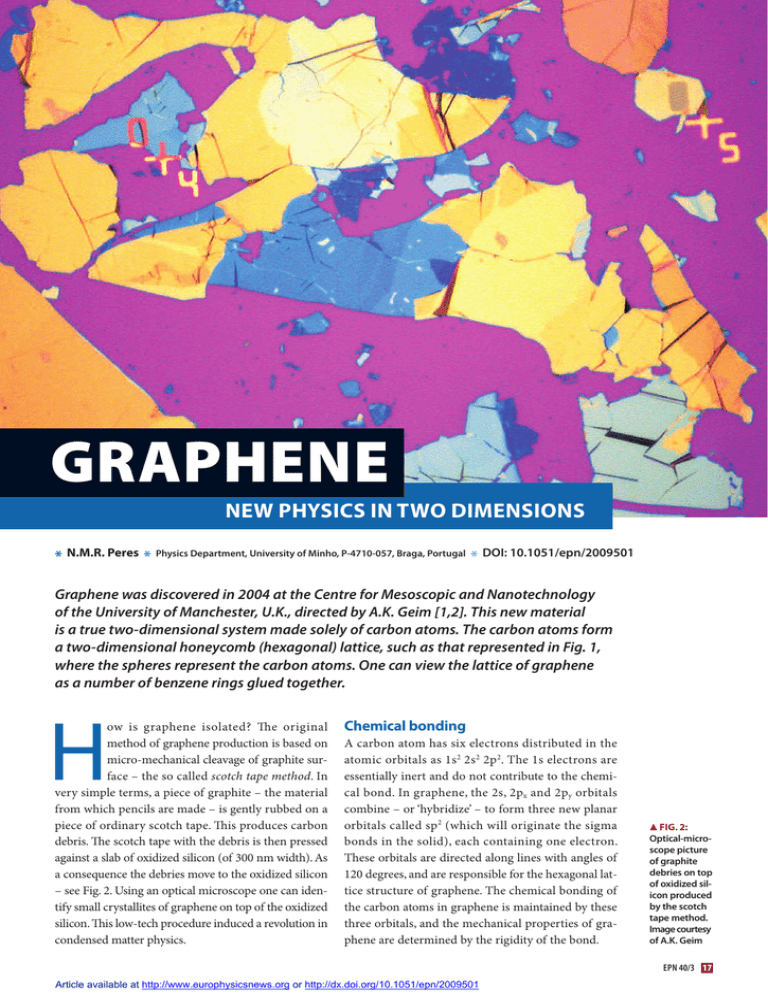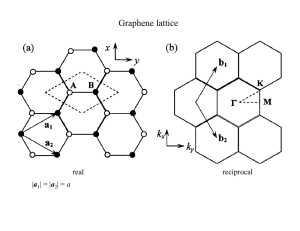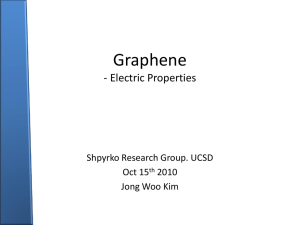- Europhysics News
advertisement

GRAPHENE nEw PhySiCS in Two DimEnSionS * n.m.R. Peres * Physics Department, University of Minho, P-4710-057, Braga, Portugal * DOI: 10.1051/epn/2009501 Graphene was discovered in 2004 at the Centre for Mesoscopic and Nanotechnology of the University of Manchester, U.K., directed by A.K. Geim [1,2]. This new material is a true two-dimensional system made solely of carbon atoms. The carbon atoms form a two-dimensional honeycomb (hexagonal) lattice, such as that represented in Fig. 1, where the spheres represent the carbon atoms. One can view the lattice of graphene as a number of benzene rings glued together. H ow is graphene isolated? e original method of graphene production is based on micro-mechanical cleavage of graphite surface – the so called scotch tape method. In very simple terms, a piece of graphite – the material from which pencils are made – is gently rubbed on a piece of ordinary scotch tape. is produces carbon debris. e scotch tape with the debris is then pressed against a slab of oxidized silicon (of 300 nm width). As a consequence the debries move to the oxidized silicon – see Fig. 2. Using an optical microscope one can identify small crystallites of graphene on top of the oxidized silicon. is low-tech procedure induced a revolution in condensed matter physics. Chemical bonding A carbon atom has six electrons distributed in the atomic orbitals as 1s 2 2s 2 2p 2. The 1s electrons are essentially inert and do not contribute to the chemical bond. In graphene, the 2s, 2px and 2py orbitals combine – or ‘hybridize’ – to form three new planar orbitals called sp 2 (which will originate the sigma bonds in the solid), each containing one electron. These orbitals are directed along lines with angles of 120 degrees, and are responsible for the hexagonal lattice structure of graphene. The chemical bonding of the carbon atoms in graphene is maintained by these three orbitals, and the mechanical properties of graphene are determined by the rigidity of the bond. 䉱 FiG. 2: Optical-microscope picture of graphite debries on top of oxidized silicon produced by the scotch tape method. Image courtesy of A.K. Geim EPN 40/3 17 Article available at http://www.europhysicsnews.org or http://dx.doi.org/10.1051/epn/2009501 feaTureS graPHeNe, New PHySiCS iN Two dimeNSioNS e reader certainly noticed that one orbital remained, the pz orbital with one electron. is orbital is perpendicular to the plane formed by the carbon atoms. As in the case of the 2s, 2px and 2py orbitals, the pz orbitals of different atoms combine to form the pi-bonds. Each pz orbital contributes with one electron, and therefore graphene is a system with one electron per lattice site (the carbon atoms define the Graphene offers sites in the lattice). is is called a halfthe possibility to filled system. e pi-orbitals are study relativistic responsible for the unusual electronic effects in table- properties of graphene. top experiments It should be noted that graphene can be considered the raw material for other existing forms of pure carbon. For example, graphite is a stack of graphene planes weakly coupled; carbon nanotubes are made of rolled-up graphene; and fullerenes are made of wrapped graphene, by introducing the right amount of pentagons to give the required curvature [3,4]. III lattice structure and band structure As already mentioned, graphene is a two-dimensional hexagonal lattice made of carbon atoms. The hexagonal lattice is not a Bravais lattice. Instead it can be viewed as two interpenetrating triangular lattices, each containing one set of equivalent carbon atom sites – the A and B carbon sites (see Fig. 3). One should note that from a chemical point of view the two carbon atoms are exactly identical. Since the unit cell contains two carbon atoms, one A and one B, the energy spectrum originating from the pi-orbitals has two energy bands - a valence band (at lower energies) and a conduction band (at higher energies). As said before, graphene is a half-filled system and therefore the valence band is completely filled. In condensed matter physics, the electronic properties of a system are determined by the nature of the spectrum close to the last filled states, the energy of which defines the Fermi level. Therefore, the physics of graphene is determined by the nature of the energy spectrum close to the top of the valence band and to the bottom of the conduction band. The interaction of the pi-electrons with the hexagonal lattice gives graphene a very unusual energy spectrum. Both the valence and the conduction bands are represented in Fig. 4. A number of very interesting and peculiar features emerge from this figure. First it is clear that the valence and the conduction bands touch each other at a number of finite momentum values. The momentum values at which the two bands touch are termed Dirac points (there are two in the Brillouin zone). As a consequence, graphene's spectrum does not have an energy gap. On the other hand, since the bands only touch at two momentum points the density of states is zero at the corresponding energy. Therefore, graphene is sometimes termed a zero-gap semiconductor with vanishing density of states at the Fermi energy. Even more interesting is the form of the valence and the conduction bands close to the Dirac points. ey show a conical shape, with negative (valence) and positive (conduction) energy values. In fact, the energy spectrum of graphene close to the Dirac point is well represented by the relation E = ±νF p 䉱 FiG. 1: Artistic view of the hexagonal lattice of graphene. Notice that the graphene lattice has two types of edges: zigzag (top and bottom edges) and armchair (right and left edges). Image obtained from: http://news.thomasnet.com/IMT/archives/. 18 EPN 40/3 (1) where νF is the Fermi velocity, p is the momentum, and E is the energy. e value of νF is c/300, where c is the speed of light. e energy given by equation (1) resembles that of ultra-relativistic particles (sometimes one says that electrons loose their mass in graphene). is is a truly amazing result: as a consequence of the interaction between the lattice and the pi-electrons, an effective theory emerges where the electrons (or better: the quasi-particles) are massless Dirac electrons. is is a good example of complex emergent behavior, in the spirit of the classic article of P.W. Anderson [5]. graPHeNe, New PHySiCS iN Two dimeNSioNS feaTureS e result of equation (1) should be contrasted with the electronic spectrum of an ordinary metal or semiconductor, which is given by E = p2/(2m), where m is the effective mass of the electrons inside the material (in a semiconductor m can be different for holes and for electrons, with m being negative for holes). e dependence of the energy on the square of the momentum is an indication that the Schrödinger equation is the appropriate one to describe the physics of these systems at low energies. Note that in graphene the primary quantum problem is described by the Schrödinger equation with two terms: the kinetic energy and the periodic potential produced by the carbon atoms arranged in the hexagonal lattice. is formulation describes the physics at all energy scales (within the pi-bands). However, the important physics of graphene takes place close to the Dirac point, where the Fermi energy is located. It can be formally shown [6] that, close to the Dirac point, the equation describing the low-energy physics is not the Schrödinger equation but the massless Dirac equation in two-dimensions, as one would guess from the fact that the energy in equation (1) is linear in momentum, with positive and negative energies. So one moves from electrons interacting with a periodic potential to free massless Dirac particles moving at the effective velocity of light νF . As a consequence, the electronic wave-function in graphene is not a scalar field1 but has a spinorial nature, where the spinor has two entries, reflecting the fact that the original lattice has A and B types of carbon atoms. Graphene therefore offers the possibility of studying relativistic effects in table-top experiments. Since traditional condensed-matter physics knowledge for describing the electronic properties of materials is based on the properties of solutions of the Schrödinger equation, graphene opens a new research frontline, since the electronic properties of systems described by spinorial solutions of the Dirac equation is lacking. In fact, the electronic properties of Dirac electrons are different from those of Schrödinger electrons. Some properties of Dirac electrons in graphene Graphene has a number of fascinating properties from both elastic and electronic points of view. For example, the stiffness of graphene has been proved to be extremely large, with a Young modulus E=1.0 TPa, making it the strongest material ever measured. is is a consequence of the sigma-bonds and not of the fact that the lowenergy physics is described by the massless Dirac equation. Furthermore, the material is chemically stable and almost impermeable to gases. In addition, the mate- rial has high thermal conductivity, can withstand large current densities [1], has ballistic transport over submicron scales, with very high mobilities in its suspended form [1] (in the first experiments the electronic properties of graphene were measured with the material on top of oxidized silicon; more recently the substrate was etched away leaving graphene standing free). Finally, it shows ambipolar (electron and hole) behavior, one of the first properties to be measured [1]. is latter property is a direct consequence of the massless Dirac nature of the pi-electrons in graphene. e density of charge carriers in graphene can be tuned by the field effect using a backgate [1]. is setup allows tuning of the Fermi level above or below the Dirac point. When the Fermi level is tuned below the Dirac point the valence band is filled with holes; when the Fermi level is tuned above the Dirac point the conduction band is filled with electrons. ese two possibilities give graphene its ambipolar nature, with the Hall effect measurements giving direct evidence on the charge of the carriers. At large magnetic fields another amazing consequence of Dirac electrons in graphene kicks in: the chiral quantum Hall effect [7,8], where the origin of the name stems again from the fact that electrons in graphene are described by the massless Dirac equation. Contrary to the traditional quantum Hall effect observed in the two-dimensional electron gas, the quantization rule of the Hall conductivity is given by 2 σHall = ±4e (n+1/2)/h, n = 0, 1, 2, ... (2) where e is the electron charge and h the Planck constant. 䉱 FiG. 3: Graphene hexagonal lattice made of two interpenetrating triangular lattices. The nodes of each triangular lattice define the carbon atoms of type A (red) and B (blue). Also represented are the unit cell vectors a1 and a2. note 1 We are not considering the electron's real spin EPN 40/3 19 feaTureS graPHeNe, New PHySiCS iN Two dimeNSioNS How can we interpret equation (2)? e number four in front of the equation is in fact the result of a factor two due to the spin degeneracy and another factor two due to the two Dirac points. e integer number n determines which energy levels are contributing to the charge transport in the system. Finally, the term ½ is the signature of the presence of Dirac electrons in the system [9],and does not show up in the case of Schrödinger electrons. Another noticeable effect of Dirac electrons in graphene is the transparency of the material to light [10]. It is found experimentally and explained theoretically that the transmissivity T (percentage of light passing through the material) of graphene is given by the simple relation T = 1-πα ≈ 98% 䉲 FiG. 4: Band structure of graphene as a function of the momentum kx and ky. One notices the valence band (at lower energy) and the conduction band (at higher energy). A zoom-in shows the bands close to the point where they touch each other. (3) where α is the fine-structure constant. at is, the transmissivity of graphene depends only on fundamental constants, with no reference to any of the material parameters. is is a rare situation in condensed matter physics, with parallels only in the quantum Hall effect, the flux quantization in superconductors or vorticity quantization in superfluids, and conductance quantization. Again this result is a consequence of equation (1). e high transmissivity of graphene (98%) and its metallic behavior opens the possibility of using graphene in the solar cell industry and in gateable displays as transparent metallic electrode. Since the original work of Klein [11] it became clear that Dirac electrons respond differently from Schrödinger electrons to electrostatic potentials. In fact, massless Dirac electrons pass through a potential barrier with probability one at normal incidence, at odds with its Schrödinger counterpart. is result became known as Klein tunneling. In technical terms, this can be explained using the concept of chirality. is concept introduces a new quantum number that is conserved in massless Dirac particles. e head-on collision of the Dirac electron with the potential barrier has to conserve this quantum number and this implies tunneling with probability unity [12]. is, in turn, has observable consequences in the transport properties of electrons in graphene [13]. Conclusions We have surveyed only some of the many interesting properties of graphene. ere are many more fascinating aspects of graphene that can not be covered in such a short space and the interested reader can pursue his/her readings in some of the reviews listed in the references list [4,6,12]. A physicist working in graphene is required to have notions of condensed matter, elasticity, high-energy physics,and material science.erefore,graphene physics is an interdisciplinary research field with new fundamental physics and several promising applications [4],making it a truly exciting research area. ■ About the author Prof. Peres is Associate Professor at the Physics Department of Minho University in Portugal since 2002, and has been visiting professor at Boston University, U.S.A.. Acknowledgments e author acknowledges A.H. Castro Neto, P. Guinea, J.M.B.Lopes dos Santos,A.K.Geim,K.Novoselov,E.Castro, andV.M.Pereira for many hours of enthusiastic discussions. References [1] K. S. Novoselov, A.K. Geim, S.V. Morozov, D. Jiang, Y. Zhang, S.V. Dubonos, I.V. Grigorieva, and A.A. Firsov, Science 306, 666 (2004). [2] K.S. Novoselov, D. Jiang, T. Booth, V.V. Khotkevich, S.M. Morozov, A.K. Geim, PNAS 102, 10451 (2005). [3] A.H. Castro Neto, F. Guinea, N.M.R. Peres, Physics World 11, 33 (2006). [4] A.K. Geim and K.S. Novoselov, Nature Materials 6, 183 (2007). [5] P.W. Anderson, Science 177, 393 (1972). [6] A.H. Castro Neto, F. Guinea, N.M. R. Peres, K.S. Novoselov, and A.K. Geim, Review of Modern Physics 81, 109 (2009). [7] K.S. Novoselov, A.K. Geim, S.V. Morozov, D. Jiang, M.I. Katsnelson, I.V. Grigorieva, S.V. Dubonos, and A.A. Firsov, Nature 438, 197 (2005). [8] Y. Zhang, Y.-W. Tan, H.L. Stormer, and P. Kim, Nature 438, 201 (2005). [9] N.M.R. Peres, F. Guinea, A.H. Castro Neto, Physics Review B 73, 125411 (2006). [10] R.R. Nair, P. Blake, A.N. Grigorenko, K.S. Novoselov, T.J. Booth, T. Stauber, N.M.R. Peres, and A.K. Geim, Science 320, 1308 (2008). [11] A. Calogeracos and N. Dombey, Contemporary Physics 40, 313 (1999). [12] C.W.J. Beenakker, Review of Modern Physics 80, 1337 (2008). [13] N. Stander, B. Huard, D. Goldhaber-Gordon, Observation of Klein tunneling in graphene p-n junctions, arXiv:0806.2319 . 20 EPN 40/3





